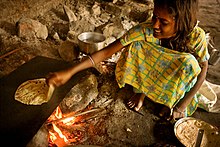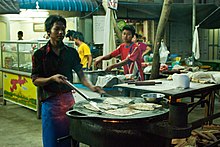Chappathi / Roti
About Chapati :
Chapati, Chapatti, Chappati or Chapathi is an unleavened flatbread (also known as roti) from Nepal, India and Pakistan. It is a common staple of cuisine in South Asia as well as amongst South Asian expatriates throughout the world. Versions of the dish are also found in Central Asia and the Horn of Africa in countries such as Kenya, Tanzania, and Uganda, with the laobing flatbread serving as a local variation in China. Chapati is known as doday in Pashto.
The word 'Chapati' means "flattened round" in Indian languages. Chapati is noted in Ain-i-Akbari, a 16th-century document, by Mughal Emperor, Akbar’s vizier, Abu'l-Fazl ibn Mubarak.
Chapatis are one of the most common forms in which wheat, the staple of northern South Asia, is consumed. Chapati is a form of roti or rotta (bread). The words are often used interchangeably. While roti or rotta refers to any flat unleavened bread, chapati is a roti made of whole wheat flour and cooked on a tava (flat skillet).
Cooking:
Chapatis are made from a firm dough made from flour (whole grain common wheat), 'Atta' in Urdu/Hindi/Punjabi/Nepali/Bengali, and water. Some people also add salt and/or oil to the dough. Small portions of the dough are rolled out into discs much like a tortilla, using a rolling pin. The rolled-out dough is thrown on the preheated dry skillet and cooked on both sides. In some regions of Nepal , western india it is only partly cooked on the skillet, and then put directly on a high flame, which makes it blow up like a balloon. The hot air cooks the chapati rapidly from the inside. In some parts of northern India (e.g. Punjab) and Pakistan, this is called a phulka (that which has been inflated).
Often, the top of a chapati is slathered with butter or ghee (clarified butter). A piece of chapati is torn off and used to pick up the meat or vegetable dish(es) that make the meal. It is folded into a sort of loose cone and used as a scoop to eat the more liquid dishes at a meal like paneer, or sena-galu.
Chapati sizes (diameter and thickness) vary from region to region and kitchen to kitchen. In Gujarat, for example, the chapati is called a 'rotli' and can be as thin as tissue paper. Chapatis made in domestic kitchens are usually not larger than 6-7 inches in diameter since the 'tava' on which they are made comes in sizes that fit comfortably on a domestic stove top. Tavas were traditionally made of unglazed earthenware, but are now typically made from metal. There are also electric tavas manufactured in Nepal and India. The shape of the rolling pin also varies from region to region. Some households simply use a kitchen work top as a sort of pastry board, but homes have round flat-topped 'boards' specifically for rolling out chapatis that may be made of wood or stone.
Flat unleavened breads in South Asia come in many forms; the chapati is only one of them. A rotta, made of a dough similar to that used to make chapatis and cooked in an oven, is a 'tandoori roti'. The combination of wheat flour with one or more flours (e.g. chickpea, maize, or millet) will produce a "missi roti". Rottas made with pearl millet (bajra) or maize (makka) orjowar flour usually carry the name of the flour, as in "bajra roti" or "makke ki roti" (or "bhakri" in marathi). Flat breads like chapati and roti are traditionally a food of northern South Asia. The peninsular south, the east and northeast and the Kashmir are primarily rice-eating cultures.
In southern India, there is a distinction made between a 'chapati' and its layered fried version the 'paratha'. 'Parathas' usually have a filling inside, such as spinach, cooked radish, or potato. Also now the 'tandoori roti' is to be found in the smallest towns. Many people confuse roti and chapati, but chapatis are made of whole wheat flour, whereas rotis are made of all-purpose flour.
Ingredients:
Whole Wheat Flour - 2 cups
Oil - 1 tbsp
Heavy Cream / Milk / Yogurt - 2 tbsp
Salt - Optional
Water - 1 cup (extra 2 tbsp more or less)
All Purpose Flour - for Dusting roti's While making them(Use All purpose flour,don't use wheat flour for this,This will Prevent any dry flour dust from burning in tawa while making them)
Method:
1.Take the Flour in a mixing bowl.
2.Add Salt (its totally optional)3.Add Oil
4.Add Cream / Milk / Yogurt(This helps in making very soft chappathis,and they stay softer for a long time too)
5.Mix them well ,until they are all incorporated.
6.Then add water little by little and make it to a sticky and soft dough.
7.keep kneading until the dough is not sticking to hands anymore and forms a ball.
Then Grease a bowl with oil and put the dough in it.
8.Rotate the dough,so its coated with oil on all sides.
9.Then Cover it with a damp paper towel or a damp kitchen towel.Let it sit for minimum 30 min.
10.After 30 min,remove towel and take the dough and knead them once again.
11.Now make Roundels of tennis ball size .
12.Dust it in dry All purpose flour and make into roti's by using rolling pin.
14.Once you see some bubbles coming up ,press it with a spatula on all sides by rotating roti (like only 1 min,don't wait longer ,it will become dry and burnt)
15.Flip the roti to other sides.
16.Press it with spatula with same rotating motion(also like only 1 min).Then remove it.
17.Line a container with lid with a paper towel .
18.Place the chapati on the paper towel.
19.Then cover it on top with another towel.(this prevents any steamed water dripping from lid falling on top of roti and make them soggy)
20.Cover it with lid.(To keep it warm)
21.Make all roti's and place them one over the other in the container and top it with the paper towel(this prevents any steamed water dripping from lid falling on top of roti and make them soggy)
22.Make all Roti's and serve them with your favourite side dish.
Tips:
1.Using All Purpose Flour for Dusting Is important.
2. USe Cream / Milk / Yogurt in making dough is important too.







































0 Comments